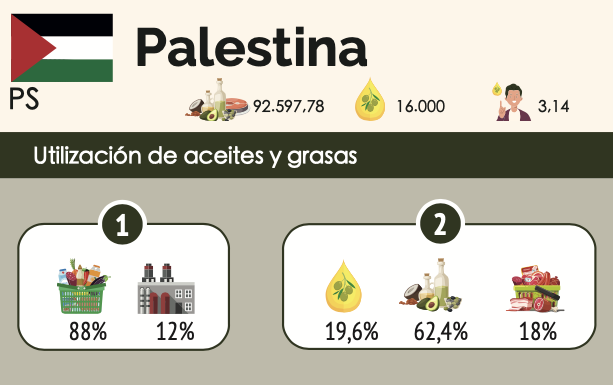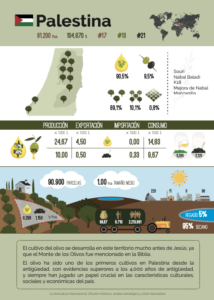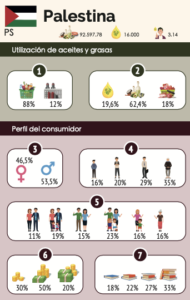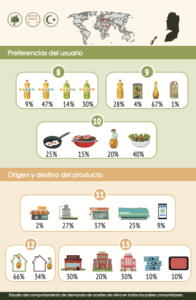Olive cultivation in Palestine developed between 2000 and 4000 BC.
The olive tree has existed in Palestine since ancient times, as it dates back more than 4,000 years. It has always played a crucial role in the cultural, social and economic characteristics of the country.
It has 91,200 hectares of olive groves, ranking 17th in terms of area under cultivation. It is also ranked 13th in olive oil production and 13th in table olive production. Of the total production, 90.5% corresponds to olive oil production and 9.5% to table olive production.
Of the total cultivation, traditional cultivation accounts for 89.1%, followed by intensive cultivation (10.1%) and finally, super-intensive cultivation (0.8%). Of this crop, 95% is rainfed and the remaining 5% is irrigated.]
Turkey produces 24,670 tons of oil. Of this, 57% belongs to a superior quality oil and 43% to a lower quality oil. Of the total oil produced, 4,500 tons are marketed abroad. With respect to the production of table olives, they produce around 10,000 tons, most of which are destined for export to other countries.
It has 90,900 olive grove plots, of which the average size is 1 hectare. The yield per hectare is 0.299 tons per hectare of olive oil and 1.15 tons per hectare of table olives.
It has 220 olive mills, 11 olive oil mills and 90 table olive plants. It employs 9 thousand people in the sector and the turnover generated by the olive oil sector is almost 90 million euros.
As for consumption, 19.6% of the total of animal and vegetable fats corresponds to olive oil, which translates to 16,000 tons of olive oil. Olive oil is consumed in greater proportion by men than by women, at 53.5% and 46.5%, respectively.
With respect to age, those over 65 years of age predominate with respect to the other age ranges, with a percentage that oscillates 35%. In terms of family structure, middle-aged families with children predominate in olive oil consumption, with 23%, followed by young families with children (19%).
Those families with a lower average income level consume a higher proportion of olive oil than those with a higher income level. In addition, individuals with university studies consume more olive oil than those with no studies at all.
According to the type of oil, in Palestine the most consumed oil is olive oil with 47%, followed by extra virgin olive oil with 30%. The least consumed oil is olive pomace oil (9%).
In terms of the different existing containers, the one most frequently used is the glass container (67%), followed by the PET container (28%). The most frequent use of olive oil is raw, for seasoning (40%), followed by frying (25%).
The establishments most used by the Palestinian population to purchase olive oil are supermarkets (37%) and hypermarkets (25%).
The majority consume olive oil in their own homes (66%), but it is true that the remaining 34% do so outside the home. Outside the home, the establishments where the greatest proportion of olive oil is consumed are bars and restaurants (30%), hotels (30%) and collectivities (20%).




